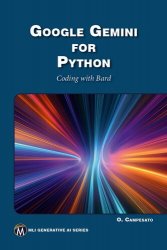Google Gemini for Python: Coding with Bard
- Добавил: literator
- Дата: 22-03-2024, 06:56
- Комментариев: 0
 Название: Google Gemini for Python: Coding with Bard
Название: Google Gemini for Python: Coding with BardАвтор: Oswald Campesato
Издательство: Mercury Learning and Information
Год: 2024
Страниц: 203
Язык: английский
Формат: pdf (true), epub (true)
Размер: 10.1 MB
This book provides a bridge between the worlds of Python 3 programming and Generative AI, aiming to equip readers with the skills to navigate both domains with confidence. It begins with an introduction to fundamental aspects of Python programming, which include various data types, number formatting, Unicode and UTF-8 handling, and text manipulation techniques. In addition, you will learn about loops, functions, data structures, NumPy, Pandas, conditional logic, and reserved words in Python. Further chapters show how to handle user input, manage exceptions, and work with command-line arguments. The text then transitions to the realm of Generative AI, discussing its distinction from Conversational AI. Popular platforms and models, including Bard (now called “Gemini”) and its competitors, are presented to give readers an understanding of the current AI landscape. The book discusses the capabilities of Bard, its strengths, weaknesses, and potential applications. Finally, you will learn how to generate a variety of Python 3 code samples via Bard.
The first half of this chapter starts with an introduction to the Python NumPy package, followed by a quick introduction to Pandas and some of its useful features. The Pandas package for Python provides a rich and powerful set of APIs for managing datasets. These APIs are very useful for Machine Learning and Deep Learning tasks that involve dynamically “slicing and dicing” subsets of datasets. The first section contains examples of working arrays in NumPy and contrasts some of the APIs for lists with the same APIs for arrays. In addition, you will see how easy it is to compute the exponent-related values (such as squares and cubes) of elements in an array. The second section introduces subranges, which are very useful (and frequently used) for extracting portions of datasets in Machine Learning tasks. You will see code samples that handle negative (-1) subranges for vectors as well as for arrays, because they are interpreted one way for vectors and a different way for arrays.
Features:
Includes a chapter on how to generate a variety of Python 3 code samples via Gemini
Covers basic concepts of Python 3 such as loops, conditional logic, reserved words, user input, manage exceptions, work with command-line arguments, and more
Includes companion files for downloading with source code and figures(available from the publisher with Amazon proof of purchase)
The target audience:
This book is intended primarily for people who want to learn both Python and how to use Bard with Python. This book is also intended to reach an international audience of readers with highly diverse backgrounds in various age groups. In addition, this book uses standard English rather than colloquial expressions that might be confusing to those readers. This book provides a comfortable and meaningful learning experience for the intended readers.
Contents:
Скачать Google Gemini for Python: Coding with Bard
Внимание
Уважаемый посетитель, Вы зашли на сайт как незарегистрированный пользователь.
Мы рекомендуем Вам зарегистрироваться либо войти на сайт под своим именем.
Уважаемый посетитель, Вы зашли на сайт как незарегистрированный пользователь.
Мы рекомендуем Вам зарегистрироваться либо войти на сайт под своим именем.
Информация
Посетители, находящиеся в группе Гости, не могут оставлять комментарии к данной публикации.
Посетители, находящиеся в группе Гости, не могут оставлять комментарии к данной публикации.

